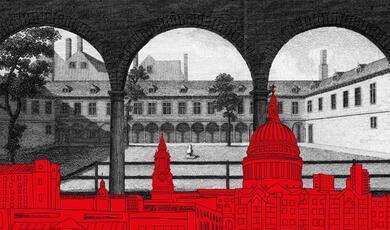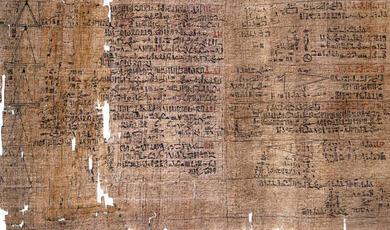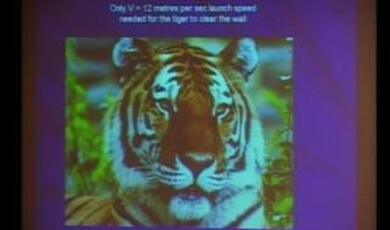Much ado about zero
Share
- Details
- Text
- Audio
- Downloads
- Extra Reading
The concept of zero developed in many cultures over thousands of years. Why did such a 'natural' idea take so long? This lecture illustrated the wide-ranging mathematical achievements of China, India and Central America over a thousand-year period - some not to be rediscovered in Europe for a further thousand years - before returning to the elusive origins of zero.
Download Text
MUCH ADO ABOUT ZERO
Professor Robin Wilson
Introduction
This is the last of my lectures on the multi-cultural origins of mathematics, shown here on this time-line. In my earlier lectures I introduced you to the mathematics of Egypt and Mesopotamia and of Ancient Greece. Today we’ll be visiting China, India and Central America, and there’ll also be much ado about zero.
But first let’s take stock and revisit some of our earlier counting systems. The cultures we’ve seen, and those we’ll meet today, have all needed to count the objects around them – 5 cows, 12 people, and so on – but if there were no things there, they didn’t feel the need to count them: they had no need to introduce a symbol for 0. Even less did they need to involve negative numbers: –20 cows would have been meaningless.
As you may remember, the Egyptians developed a grouping system of counting, with separate symbols for 1, 10, 100, etc., repeated as many times as necessary, but with no symbol for 0. The Greeks had separate symbols for 1 up to 9, 10 up to 90 and 100 up to 900, but in their geometrical style of mathematics numbers were represented by lines, so a zero would have had zero length and wouldn’t have appeared.
However, the situation was rather different for the Mesopotamians who had a place-value system based on 60. With such a place-value system, the actual number depended on the context, and we saw a table of squares in which the same symbol could represent 41, or 41 × 60 (= 2460), or (40 × 60) + 1 (= 2401), and it was only from the context that we realised that the last one was intended. This idea of context is quite familiar to us: 6-50 might represent time ( ten to seven ), or the cost of a bus trip to Cambridge (£6.50), or the cost of a flight to Singapore (£650).
In the early Mesopotamian tablets of around 1800 BC, gaps were sometimes left to indicate no entry in that position, but in the later Babylonian period of around 600 BC a special place holder symbol was used to represent 0 – just as we now use zero to distinguish 305 from 35 or from the two numbers 3 and 5. However, they didn’t employ a final zero, so context was still used to distinguish between 4 and 4 × 60, for example.
The other use of zero is as a number that we can calculate with. In this context, the difference between 2 and 2 (which is zero) has the same mathematical status as the difference between 3 and 2 (which is the number 1). As we’ll see, the use of zero as a number did not emerge until much later, in India.
Today we’ll be looking at the mathematics of China and India. Around 250 BC in India, King Ashoka’s edicts were written on various pillars around the kingdom, and numerical information appeared on these pillars. It was written in a place system based on 10, and seems to have been the origin of what we now call the Hindu-Arabic numerals, with their separate columns for units, tens, hundreds, and so on.
The Chinese had a similar scheme with their counting boards, in which there were separate compartments for units, tens, hundreds, and so on – here are 6736 and 2101 (as we now write them). There are only nine different symbols (1 to 9), although each has two forms (horizontal and vertical) so that the calculator could distinguish more easily between adjacent compartments – so these 1s are the same, whereas these 6s are different. In this context it would be natural to introduce a zero symbol for an empty box – though the Chinese didn’t do so.
The Indians did, however. Whether they were familiar with Chinese counting boards is unknown, though the Chinese visited India and the boards were transportable (like lap-tops), so it is quite possible. In any case, the Indian number system developed as a place-value system based on 10, using only the numbers 1 to 9 (unlike the Egyptian and Greek systems), and eventually (possibly around 400 AD) including also the number 0.
China
I’d now like to look at the mathematical activities of China and India in more detail, although primary source material is very sketchy. In particular, the Chinese wrote on bamboo, and on paper, which do not survive the centuries.
There is an ancient Chinese legend about the Emperor Yu standing on the banks of the river Lo (a tributary of the Yellow river), when a tortoise emerged from the river with a pattern of numbers on its back – in fact, a 3 × 3 magic square, in which the sum of the numbers in each row, each column, and the two diagonals, were all the same: 4 + 9 + 2 = 15, 2 + 5 + 8 = 15, and so on. Over the centuries this particular pattern of numbers came to acquire great religious and mystic significance, and appeared in many different forms, as you can see. Although Emperor Yu lived around 2000 BC, there is no evidence of the story until much later – possibly as late as the Han dynasty, which started in 206 BC.
It was also possibly around this time that two classic Chinese texts appeared. The first was the Zhou-bei suanjing or Chou-pei suan ching(The arithmetical classic of the gnomon and the circular paths of Heaven), which contained a celebrated dissection proof of Pythagoras’s theorem, different from the one I showed you last time: if we draw the square on the hypotenuse and then move two triangles in the figure, we get the sum of the squares on the other two sides.
Another classic Chinese problem type of the time, which can be solved using Pythagoras’s theorem, are problems of broken bamboos. For example, there is a bamboo 10 feet high, the upper end of which being broken reaches the ground 3 feet from the stem. Find the height of the break. In modern algebraic notation, which the Chinese didn’t have, we can call the answer x and the rest of the bamboo y, so that x + y = 10 and (by Pythagoras’s theorem) x 2 + 3 2 = y 2. Solving these equations then gives the result.
This particular bamboo problem appeared in the other great early text, the Jiuzhang suanshu, or Nine chapters on the mathematical art. This remarkable work contains 246 questions with answers but with no working shown, and may have been used as a textbook. It deals with both practical and theoretical matters – for example, there are problems from agriculture, business, surveying and engineering, and discussions of the areas and volumes of various geometrical shapes, the calculation of square roots and cube roots, the study of right-angled triangles, and the solution of simultaneous equations.
This last area in particular is very remarkable. Here’s an example. There are three types of grain, good, moderate and poor. 3 bundles of good grain, 2 bundles of moderate grain, and 1 bundle of poor grain take up 39 measures; 2 bundles of good grain, 3 bundles of moderate grain, and 1 bundle of poor grain take up 34 measures; 1 bundles of good grain, 2 bundles of moderate grain, and 3 bundle of poor grain take up 26 measures. How many of each type are there?
These days we would write down three simultaneous equations – and this is what is done here, except that they’re written in a table from left to right and vertically. We’d then manipulate the equations, using what we now call ‘Gaussian elimination’ – and that’s exactly what’s done here with the table, eventually yielding these three equations. The first gives C = 2¾, and substituting back gives B = 4¼ and A = 9¼. The Chinese method is exactly the same as the one that Gauss gave some 2000 years later, except that Gauss was the one that gets the credit.
Another Chinese topic with which you may be familiar is the Chinese remainder theorem, so-called because it apparently originated in China around 250 AD, when Sun Zi in the Sunzi suanjing (Master Sun’s mathematical manual) asked the following question. We have things of which we do not know the number. If we count them by 3s, the remainder is 2; if we count them by 5s, the remainder is 3; if we count them by 7s, the remainder is 2. How many things are there? Nowadays, we might write the question in the form: find N, where N = 2 (mod 3) = 3 (mod 5) = 2 (mod 7). The answer that Sun Zi gave is 23, and he also provided a full explanation of how to solve this problem or any other of the same type.
Another preoccupation of the Chinese was the evaluation of π, the ratio of the circumference of a circle to its diameter. We have already seen how the Egyptians tackled this problem, obtaining an answer better than the usual one of 3 that appears in the Bible. Last time we saw how Archimedes compared the perimeters of polygons drawn inside and outside the circle, starting with a hexagon and successively doubling the number of sides to 12, 24, 48, and then 96, giving the lower estimate 3 10/ 71 and the upper estimate 3 1/ 7.
In his Classic of the island in the sun of around 263 AD, Liu Hui carried on this process, doubling up to polygons with 3072 sides and obtaining the value π = 3.14159 in our decimal notation. Even more impressive, around 500 AD Zu Zhongzhi and his son extended this to polygons with 24,576 sides, thereby obtaining π to six decimal places. They also replaced the crude approximation 22/ 7 by the much better one 355/ 113, which gives π to six decimal places: this approximation wasn’t rediscovered in Europe until 1000 years later. Further improvement didn’t come until around 1400, in the Islamic world.
I’d like to finish my brief tour of Chinese mathematics by returning to magic squares. Most of the early work in this area was done by Chinese and Islamic scholars, who devised magic squares with all sorts of extra properties. For example, here is an ingenious magic square of Yang Hui (in 1275) – it’s a 9 × 9 magic square with all the rows, columns and diagonals having the same sum – and it splits into nine smaller 3 × 3 squares, each of which is a magic square.
But if you think that’s clever, look at this earlier Islamic one by al-Antaakii from the 10th century. It’s a 15 × 15 magic square, containing within it magic squares of side 13, 11, 9, 7, 5 and 3 – and moreover, the numbers are arranged so that all the odd numbers appear inside this diamond and all the even ones appear outside.
But my favourite magic square is this 16 × 16 one, constructed by none other than Benjamin Franklin. Every row, column and diagonal add up to 2056, but the numbers are so arranged that the half-rows, half-columns and half-diagonals add up to half that, which is 1028. We also get 1028 if we add up the four corners and the four middle squares. But the remarkable thing is that is if we take any 4 × 4 square inside this magic square, the numbers still add up to 2056.
India
It’s time to return to the topic of the day, and we’ll now look at Indian mathematics, concentrating in particular on three mathematicians Aryabhata the elder, Brahmagupta and Bhaskara. You may remember from last time that a Diophantine equation is one where we are interested in finding whole number solutions to equations, and Aryabhata gave the first systematic treatment of these, around 500 AD. He was also interested in trigonometry, and constructed tables of the sine function. Brahmagupta (probably the greatest of the three) discussed the idea of zero as a number to calculate with, showed how to solve quadratic equations (essentially the Mesopotamian way), and looked at a particular type of equation now called ‘Pell’s equation’. Bhaskara, much later, wrote a famous arithmetic book, called Lilavati, in which he showed how to simplify certain numbers involving square roots. In particular he gave a formula that can be used to show that the square root of (17 + √240) is equal to √12 + √5.
The title of his book has a legend associated with it – almost certainly false. Lilavati was the name of his daughter, and it was decreed that a particular time was the only auspicious time for her to marry. But as she was waiting by the water-fountain for the time to arrive, a pearl from her head-dress fell into the fountain and stopped the flow of water from which the time was being calculated. By the time she realised it, the auspicious time had passed, and she was not permitted to marry – but in consolation, her father named his arithmetic book after her!
One of Aryabhata’s main contributions was to sum various arithmetic series. For example, if we look at an arithmetic progression such as 5 + 7 + 9 + … + 31 or 10 + 13 + 16 + … + 100, we can find the sum of all the numbers in it: according to Aryabhata, The desired number of terms, minus one, halved, multiplied by the common difference between the terms, plus the first term, is the middle term. This multiplied by the number of terms desired is the sum of the desired number of terms. Or the sum of the first and last terms is multiplied by half the number of terms. This gives the expressions we use now:
sum = n { 1/ 2(n – 1)d + a} = n/2 {a + (a + (n – 1)d}.
In the 7th century Brahmagupta gave rules for calculating with zero (or cipher) and positive or negative numbers:
The sum of cipher and negative is negative; of positive and nought, positive; of two ciphers, cipher. Negative taken from cipher becomes positive, and positive from cipher is negative; cipher taken from cipher is nought. The product of cipher and positive, or of cipher and negative, is nought; of two ciphers is cipher. He then gets very confused: Cipher divided by cipher is nought. Positive or negative divided by cipher is a fraction with that as denominator.
It would be many centuries before mathematicians really understood the problems caused by dividing by zero.
One of Brahmagupta’s main concerns was cyclic quadrilaterals – where the corners of a quadrilateral lie on a circle. If the sides are a, b, c, d, he obtained a formula for the area of the quadrilateral, and he also found formulas for the two diagonals. But I particularly like his method of construction cyclic quadrilaterals from right-angled triangles. If we have two right-angled triangles, so that a 2 + b 2 = c 2 and A 2 + B 2 = C 2, we can calculate the four numbers aC, cB, bC and cA. Brahmagupta showed that these always give the lengths of a cyclic quadrilateral – and that moreover, the diagonals must be at right angles to each other. For example, if we start with the right-angled triangles 3 2 + 4 2 = 5 2 and 7 2 + 24 2 = 25 2, the formula gives us the sides 75, 120, 100, 35, which we can scale down to 15, 24, 20, 7, which are the lengths of the sides of a cyclic quadrilateral.
Both Brahmagupta and Bhaskara worked extensively on a particular equation, now known as Pell’s equation – an incorrect assignation by Euler. This equation has the form Cx 2 + 1 = y 2, and we are required to find whole number solutions for a given value of C. For example, if C = 3, we have to find whole numbers x and y that satisfy the equation 3x 2 + 1 = y 2. One easy-to-spot solution is found by putting x = 1; then y = 2. Another is found by putting x = 4; then y = 7. But if we put x = 2, then there’s no value for y. Brahmagupta and Bhaskara described a method for finding new solutions from old ones – starting with x = 1, y =2, we can successively find x = 4, y = 7; then x = 15, y = 26; then x = 56, y = 97; and so on.
Bhaskara asked: Tell me, O mathematician, what is that square which multiplied by 8 becomes – together with unity – a square. Here, 8x 2 + 1 = y 2, which has the easy solution x = 1, y = 3. This can then be used to find other solutions, such as x = 6 (so 8x 2 = 288), giving y = 17.
The hardest examples they came across were C = 61 and C = 67, but they still managed to find solutions: for C = 67, the simplest solution is x= 5967 and y = 48,842.
Before leaving India, I’d like to mention some early work on permutations and combinations – the area of mathematics we now call combinatorics. In a 6th-century BC medical treatise, Sushruta was investigating the number of ways of systematically combining six tastes – sweet, acid, saline, pungent, bitter and astringent – and found that two of them can be chosen in 15 ways, three can be chosen in 20 ways, and so on. Around 300 BC, the Jainas similarly studied combinations of five senses, and of men, women and eunuchs, and around 200 BC, Pingala investigated combinations of short and long syllables in a metrical poem.
Much more substantial was the work of Varahamihira, around 550 AD, who desired to find the number of perfumes that could be made from 4 ingredients chosen from 16. He gave the correct answer of 1820.
Bhaskara was also interested in such problems, and asked: How many are the variations of form of the god Sambhu, by the exchange of his ten attributes held reciprocally in his several hands – namely: the rope, the elephant’s hook, the serpent, the tabor, the skull, the trident, the bedstead, the dagger, the arrow and the bow? Statement: number of places 10. The variations of form are found to be 3,628,800. (This is the factorial number 10!)
Although Indian mathematicians were skilled in dealing with permutations and combinations, they never constructed what we now call ‘Pascal’s triangle’, which lists these numbers – we call them binomial coefficients, because they arise by multiplying out the binomial expression (a + b) n. Here’s a Chinese ‘Pascal’s triangle’ from the 1303 treatise Precious mirror of the four elements, by Zhu Shijie. The earliest Pascal triangle I know dates from around 1000 – an Islamic one of al-Karaji – 650 years before Pascal.
The Mayans
We come now to our final culture, the Mayans of Central America, where the idea of zero was firmly established. There has been a Mayan culture for many thousands of years – indeed, it still exists – but the heyday of their activities was focussed around the period from about 300 to 900 AD.
The Mayans were situated over a large area centred around Guatemala and present-day Belize and extending from the Yucatan peninsula of Mexico in the north to Honduras in the south. We have primary sources, in the form of some stone columns called stelae and a handful of codices – but regrettably most of the codices were destroyed by the Spanish conquerors who arrived in this area after the year 1500. The best-known codex is the 12th-century Dresden codex, so-called because it now resides in Dresden in Germany, and there are a couple of other surviving codices, such as the Madrid codex shown here. This one was drawn on a 22-foot length of paper made of tree bark and folded, and was intended to guide Mayan priests in ritual ceremonies involving such pursuits as hunting, planting and rainmaking.
As we’ll see, the Mayans had a fixation on the calendar, and the symbols in the middle depict the 20 days of the Mayan month drawn over and over again and going through a 260-day cycle used for forecasting. The serpents represent rain, and the other hieroglyphs have meanings also. The dots and lines at the top are Mayan numerals.
In the next codex you can see the numerals much more clearly. The Mayans essentially used a dot representing 1 and a line representing 5, and the symbol in the middle has 13 below 12. What does this mean? It means thirteen 1s combined with twelve 20s, which is 253, since the Mayans essentially used a number system based on 20. Let’s see how this works.
Here are the dot-and-line representations of the numbers from 1 to 19, and you can also see that there’s a special symbol, looking rather like an eye, for zero. One rather jolly feature of the Mayan numerals is that there was an alternative form for each number, the head-form, shown here. They can vary a bit, but 0 always has clasped hands across the lower part of the face, while 3 has a banded headdress and 4 has a bulging eye with square irid, snag tooth, and curling fangs from the back of the mouth. These head-forms appear on various columns, such as this one which can be interpreted as giving the particular date when it was constructed.
Here’s another one, representing the date 11 February in the year 526. The monkey represents ‘day’ the god’s head facing the sky represents 6 and the lower head means 10, so this glyph represents 16 days. The sum of all the glyphs here is added to the official Mayan starting date in 3114 BC giving the required date.
I mentioned that the Mayans based their number system on 20, which is almost correct. But since their number system was used mainly for keeping track of the calendar, they made a slight modification to take account of the number of days in the year. They introduced an 18 into their 20-based system, to give 360, which more closely approximated the number of days in a calendar year. So their units were based on the following scheme: 1 kin = 1 day; 20 kins = 1 uinal = 20 days; 18 uinals = 1 tun = 360 days; 20 tuns = 1 katun = 7200 days; 20 katuns = 1 baktun = 144,000 days, etc. They had no problems in calculating with such large numbers.
Here’s the largest number found on a codex – starting at the bottom, we have one 1, fifteen 20s, thirteen 360s, fourteen 7200s, and so on, giving a grand total of 12,489,781 days, or over 34,000 years.
They really were transfixed by the calendar, and to make things more complicated, they had two separate methods of keeping track of the passage of time. The first was a ritual calendar of 260 days, known as thetzolkin, consisting of thirteen months of 20 days; each day had a number and a name, such as 1 Imix, which was followed not by 2 Imix and 3 Imix but by 2 Ik and 3 Akbal, etc. The other calendar had eighteen months of 20 days, plus an extra five inauspicious days to make up the usual 365 days. These two calendars operated independently, and were also combined to give a long-count, or calendar round, in which the number of days was the least common multiple of 260 and 365, which is 18,980 days, or 52 calendar years. For example, this day of 4 Ahau and 8 Cumku won’t come around again for 52 years. These periods of 52 years were then packaged up into even longer time-periods, and you’ll be alarmed to learn that they’ve predicted that the world will come to an end of the current period, in the year 2012 – and that seems a suitably cheerful note on which to end my lecture.
I shall carry on with my historical lectures next Autumn, starting with Islamic and early European mathematics on 5 October 2005. In the meantime, I’ll be introducing two famous contemporary problems – the Riemann hypothesis and the P = NP? problem – whose solutions will earn you a million dollars each if you can solve them, and there’ll also be a day for sixth-formers on 8 February at the Royal Institution, on mathematics and the computer.
Robin Wilson, 17 November 2004
This event was on Wed, 17 Nov 2004
Support Gresham
Gresham College has offered an outstanding education to the public free of charge for over 400 years. Today, Gresham College plays an important role in fostering a love of learning and a greater understanding of ourselves and the world around us. Your donation will help to widen our reach and to broaden our audience, allowing more people to benefit from a high-quality education from some of the brightest minds.


 Login
Login







